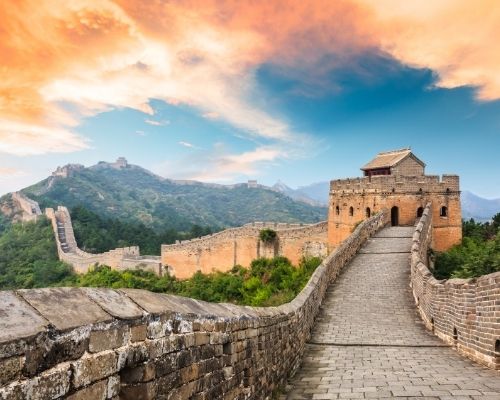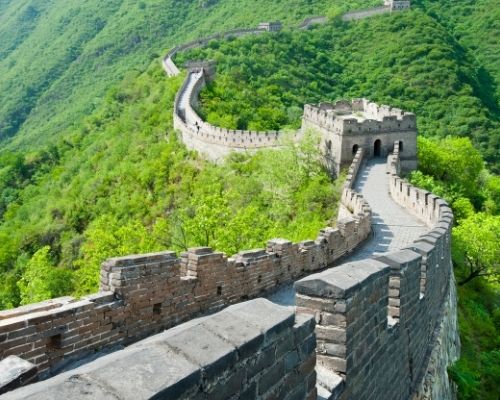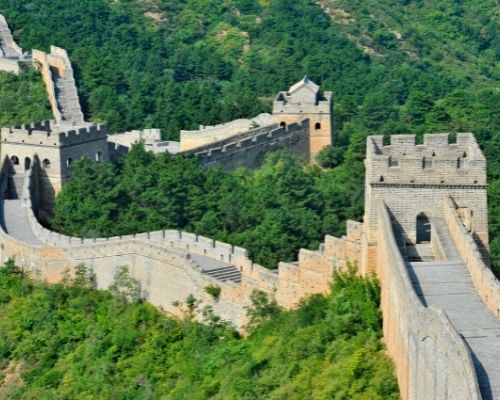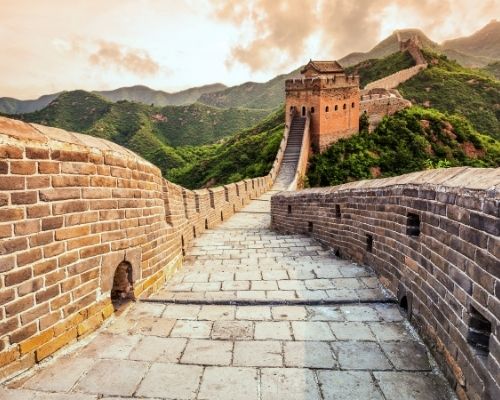The great wall of china
The Great Wall of China is a fortification built between the 5th and 17th
centuries AD in northern China to contain the invasions of nomadic tribes
mainly from Mongolia.
It is the greatest engineering work developed in history. UNESCO named the
Great Wall a World Heritage Site in 1987. Thirty years later, in 2007, the Wall
won the public competition for the New Seven Wonders of the World. Yet today
only about a third of what was once the Great Wall remains standing.
The Great Wall of China is located in northern China, bordering the Gobi Desert
(Mongolia) and North Korea. It runs through the regions of Jilin, Hunan,
Shandong, Sichuan, Henan, Gansu, Shanxi, Shaanxi, Hebei, Quinhai, Hubei,
Liaoning, Xinjiang, Inner Mongolia, Ningxia, Beijing, and Tianjin.
To build it, slave labor was used. Its construction caused so many deaths
that it gained the reputation of being the largest cemetery in the world. The
rumor said that the mortal remains of the slaves had been used as construction
material, but investigations have disproved this myth.
Another myth holds that the Great Wall can be seen from space, but it is not
true either. So what do we know about this engineering marvel? To find out,
let's learn about the main characteristics of the Great Wall of China, what its
history was and how it was built.
 |
| the great wall of china |
Characteristics of the Great Wall of China
Conceived as a defensive complex, the Great Wall crosses deserts, cliffs, rivers, and mountains of more than two thousand meters of altitude. It is divided into various sections and takes advantage of topographic features as a natural extension of its walls. Let us observe.Length of the Chinese Wall
According to official sources, the Great Wall of China reached a distance of 21,196 km. This measurement includes the perimeter of all the walls that came into being and the connection paths.However, the Great Wall project itself reached 8,851.8 km in length, which
was carried out by the Ming dynasty. This figure includes the old sections that
were rebuilt and seven thousand new kilometers.
Height of the Chinese Wall
If we think about the walls, the average height of the Chinese Wall is about 7 meters. While its towers can be around 12 meters. These measurements vary by section.Elements
The Chinese Wall is a complex defensive system, made up of different sections and architectural elements. Among them:solid walls or with battlements and loopholes,
watchtowers,
quarters,
doors or steps,
ladders.
Construction materials
The construction materials of the Chinese Wall vary according to the stage. In the beginning, soil or gravel rammed in layers used to be used. Later, branches, rocks, bricks, and mortar made with rice flour were included.The rocks used to be locally sourced. Hence, limestone was used in some
regions. In others, granite was used, and in others, stones with a certain
metal content were used that gave a shiny appearance to the wall.
The bricks were self-made. The Chinese had their ovens to bake them, and
their craftsmen often engraved their names on them.
 |
| the great wall of china |
History of the Chinese Wall (with maps)
By the 7th century BC, China was a collection of small agricultural and warrior states. They all fought each other to extend their dominance. They try different resources to defend themselves, so they started by building some protective walls.After five centuries, two states remained one of them led by Qin Shi Huang.
This warrior defeated his enemy and carried out the unification of China into a
single empire. Qin Shi Huang thus became the First Emperor and founded the Qin
Dynasty.
The Qin dynasty (221-206 BC)
Very soon Qin Shi Huang had to fight against a tireless and ferocious enemy: the nomadic tribe of the Xiongnu, from Mongolia. The Xiongnu constantly attacked China in search of all kinds of products. But they did not stop there: they also robbed their population.To gain some advantage, the First Emperor decided to build a defensive
system to save forces in combat: a great wall of about five thousand kilometers
on the northern border. He also ordered to take advantage of some pre-existing
walls.
The great work was completed in ten years with slave labor and, during its
execution, there was no less than a million dead. Along with this, the economic
cost of the wall forced to raise the tributes. Tired of the bloodshed, the
people rose in 209 BC and a civil war broke out, after which the wall was
abandoned.
The Han dynasty (206 BC-220 AD)
After the civil war, in 206 BC the Han dynasty ascended to the throne, which also had to deal with the enemy from the north. They tried to contain their ambition by facilitating trade and increasing gifts (basically bribes), but the peace between the Chinese and the Mongols was intermittent.Thus the things, the Han restored the wall and created a new section of
about five hundred meters in the Gobi desert. Its purpose was to protect the
trade routes with the West, in such a way that around the gates of the wall,
the only entrance to the Empire, authentic markets were created.
 |
| the great wall of china |
Low activity period
When the Han dynasty fell in 220 AD, the dynasties that followed did not make major modifications to the wall, that is, there were no significant changes. Some of the most deteriorated segments were hardly restored.New constructions were few and only took place between the 5th and 7th
centuries CE, and later, between the 11th and 13th centuries until the Yuan
dynasty came to power in 1271.
The Ming dynasty (1368-1644)
In the 13th century, the Mongols invaded China under the leadership of Genghis Khan and, upon his death, his grandson, Kublai Khan, succeeded in seizing power and founding the Yuan dynasty that ruled between 1279 and 1368.It was not enough to rebuild the deteriorated sections of the previous
walls, as they did. Over time, the need to completely close the northern border
of the Empire also arose. Then, the army general Qi Jiguang (1528-1588) carried
forward the wall of the Ming dynasty, which reached characteristics never seen
before.
The construction of more than seven thousand new kilometers was planned,
which makes the Ming wall the longest part of the entire fortification. Along
with this, the wall of the Ming was much more sophisticated than all the
previous ones. They perfected the construction technique, expanded its
functions, and integrated true artistic gems in the most important sections,
which attested to the wealth and power of the Empire.
How the Great Wall of China was built
The construction techniques of the Chinese Wall varied throughout the dynasties. For all of them, slave labor had to be used, which was not exactly popular with the common people.In all the historical stages of the wall, the technique created by the Qin
dynasty was used as the main base: the rammed earth, only that as the centuries
passed, more construction resources were introduced. Let's see how this process
happened.
First stage
Most of the Qin Dynasty wall was made using the compacted or layered earth technique. These layers were assembled using a wooden form that was filled with earth, and water was added to compact it.Consequently, the workers had to be careful to remove from the ground any
seeds or sprouts that could grow in the damp earth and damage the structure
inside. After one layer was completed, the formwork was removed, the level was
raised, and the process was repeated to add another layer.
This constructive technique reveals that the wall could not be used to repel
attacks but to delay them and tire the Mongols. In this way, the amount of
human energy required would also be reduced and there would be fewer
casualties.
Second stage
The construction technique was perfected over the years. In the Han dynasty, sandy gravel, red willow branches, and water began to be used.They followed the same basic principle: a wooden casing allowed gravel to be poured into it and watered down to achieve a massive effect. Once the gravel was compacted, a layer of dried willow branches was placed, which facilitated the adhesion by layers and made the wall more resistant.
Third and last stage
The wall of the Ming dynasty was characterized by technical improvement, thanks to the development of construction technologies in the Middle Ages.It was no longer limited to rammed earth or gravel. Now, the earth or gravel
was protected by a system of rock or brick walls (faces or exterior surfaces).
The pieces of the walls were fixed using a type of almost indestructible
mortar, made with rice flour, lime, and earth.
The new technique allowed to improve the constructive efficiency in the
mountainous slopes. According to experts, some sections are built on slopes of
almost 45 degrees incline, and they are not less stable for that.
To do this, they staggered the slopes, filled the steps with bricks parallel
to the ground, and these were finished off with another layer of bricks
imitating the slope. The mortar would be the key piece. Let's see the image
below:
The walls of the Ming period did not only have access gates, forts, and towers.
They also had a firearm system to repel enemy attacks. After creating
gunpowder, the Ming developed cannons, grenades, and mines.
This section of the Great Wall is also equipped with a water drainage system
that prevents its accumulation. Likewise, the Ming wall was also the object of
rich ornamentation in some sections, which functioned as signs of wealth and
power.
Structure of the Chinese Wall
The Great Wall of China was a very complex defense system, which articulated not only a defensive barrier but a whole deployment of military units for surveillance and combat, as well as drainage systems and access gates. Let's see what they consisted of and their most important features.Forts and watchtowers
The watchtowers were buildings raised vertically above the walls, to spot the enemy attack in time. The existence of about 24,000 towers has been recorded.They were equipped with a communication system to alert the troops. This
consisted of the following:
Smoke signals and flags for the day.
Light signals for the night.
The towers could have up to 15 meters and be equipped with the capacity to
house between 30 and 50 soldiers depending on the size of the place since they
had to spend the night in them in shifts of four months.
Barracks or forts were locations where soldiers lived and trained. The forts
could be fully integrated into the towers or they could be adjacent structures.
In the barracks, the soldiers had weapons, ammunition, and necessities.
Doors or steps
The Chinese wall includes gates or access passages at strategic points, destined in its time to facilitate trade. These doors - which in Chinese are called guan (å…³) - created a very active commercial life around it, as exporters and importers gathered from all over. The most important and visited passes today are Juyongguan, Jiayuguan, and Shanaiguan.Here is a list of some of the steps that exist, organized by seniority.
Jade Gate (Yumenguan). Built around 111 BC, in the Han dynasty times. It is 9.7 meters high; 24 meters wide and 26.4 meters deep. It receives that name because jade products circulated there. It was also one of the points of the Silk Road.
Yan Pass (Yangguan or Gate of the Sun). Built between 156 and 87 BC Its purpose is to protect the city of Dunhuang as well as protect the Silk Road together with the Yumen Pass (Yumenguan or Jade Gate).Yanmen Pass (Yamenguan). Located in Shanxi province.
Juyong Pass (Juyongguan or North Pass). Built-in the government of Zhu Yuanzhang (1368-1398). It is located north of Beijing. It is made up of two passes, called Paso Sur and Badaling. It is one of the most important steps along with the Jiayu Pass and the Shanghai Pass.
Jiayu Pass (Jiayuguan or Excellent Valley Pass). The gate and the entire section of the adjacent wall were built between 1372 and 1540. It is located at the westernmost end of the wall, in the province of Gansu.
Piantou pass (Piantouguan). Built around 1380. Located in Shanxi. It was a commercial point.
Shanhai Pass (Shanaiguan or East Pass). Built around 1381. Located in Hebei province, at the easternmost end of the wall.
Ningwu Pass (Ningwuguan). Built around 1450. Located in Shanxi province.
Niangzi Pass (Niangziguan). Built-in 1542. It protected the cities of Shanxi and Hebei.
 |
| the great wall of china |
Walls
In the early dynasties, the function of the walls was limited to delaying the attacks of the invaders. Over the years, the walls became more complex and included firearm attack points. The walls reached heights close to 10 meters in some places.Battlements and loopholes
The battlements are stone blocks that finish off a wall and are separated by a space, in which cannons can be located for defense.On the other hand, the loopholes or crossbows are openings in the heart of
the walls and they completely cross it. They are often found under battlements.
The loopholes are intended to allow the use of crossbows or other long-range
weapons while protecting the soldier.














No comments:
Post a Comment